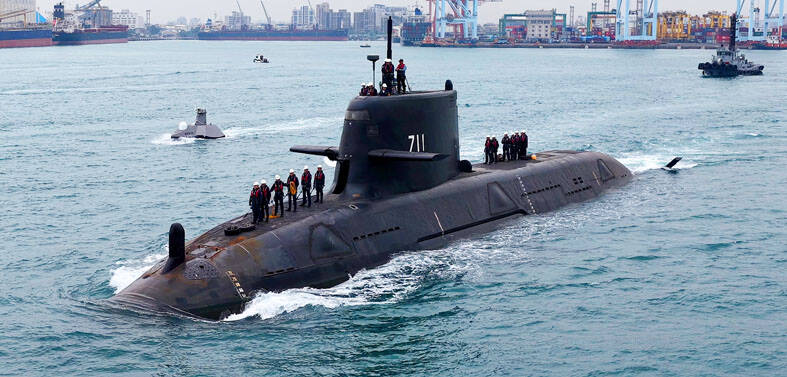More than two-thirds of the paint sold in Taiwan contain excessively high levels of lead by Singaporean and US standards, environmentalists and legislators said.
The Taiwan Watch Institute last week said that 31 out of 47 paint products it tested had lead levels higher than Singapore’s limit of 600 parts per million (ppm), while 36 paint products had lead levels higher than the US’ limit of 90ppm.
Twenty-two products had lead levels of more than 10,000ppm, and lead concentration in a corrosion-resistant paint marketed under the brand name Rainbow Paints (虹牌油漆) was as high as 440,000ppm — hundreds of times higher than international standards, researcher Sun Wei-tzu (孫瑋孜) said.
Taiwan has no regulation limiting lead content in paint.
“Paint can have scarily high lead content because there is no limit on heavy metals in paints used in buildings and furniture. While there is a set of recommendations, the standards do not have any legally binding force,” institute secretary-general Herlin Hsieh (謝和霖) said.
The institute also tested paint on park facilities and playground equipment, and found that eight of the 10 tested samples had lead levels of more than 600ppm, as well as high levels of chromium and arsenic, exposing the public — especially children — to the risks of heavy metal poisoning.
“Blood lead levels of more than 5 parts per billion can cause irreversible nervous system damage in children, leading to attention deficit disorder and lower intelligence. There are 200,000 students with attention deficit disorders in Taiwan, which could be associated with lead exposure,” Chang Gung University toxicology professor Lin Chung-yin (林中英) said.
Officials at the Bureau of Standards, Metrology and Inspection — the authority in charge of coating materials — said they are mulling a limit on lead content in paint in accordance with international standards “if there are international standards for it.”
“Most industrialized countries have standards for lead paints, so do many Southeastern Asian countries. Singapore and Sri Lanka established a 600ppm limit a few years ago. The Philippines and Nepal set the limit at 90ppm. Thailand this year set the limit at 100pm. There are international standards, but the bureau does not seem to be aware of them,” Sun said.
“A public hearing on the issue was held last year, and the bureau promised to establish standards for heavy metals in paint, but six months have passed and it is still studying international standards,” Hsieh said.
Democratic Progressive Party Legislator Wu Kun-yuh (吳焜裕) said lawmakers are expected to propose a draft regulation in two months to limit lead levels in paint to less than 90ppm.

SHIPS, TRAINS AND AUTOMOBILES: The ministry has announced changes to varied transportation industries taking effect soon, with a number of effects for passengers Beginning next month, the post office is canceling signature upon delivery and written inquiry services for international registered small packets in accordance with the new policy of the Universal Postal Union, the Ministry of Transportation and Communications said yesterday. The new policy does not apply to packets that are to be delivered to China, the ministry said. Senders of international registered small packets would receive a NT$10 rebate on postage if the packets are sent from Jan. 1 to March 31, it added. The ministry said that three other policies are also scheduled to take effect next month. International cruise ship operators

NUMBERS IMBALANCE: More than 4 million Taiwanese have visited China this year, while only about half a million Chinese have visited here Beijing has yet to respond to Taiwan’s requests for negotiation over matters related to the recovery of cross-strait tourism, the Tourism Administration said yesterday. Taiwan’s tourism authority issued the statement after Chinese-language daily the China Times reported yesterday that the government’s policy of banning group tours to China does not stop Taiwanese from visiting the country. As of October, more than 4.2 million had traveled to China this year, exceeding last year. Beijing estimated the number of Taiwanese tourists in China could reach 4.5 million this year. By contrast, only 500,000 Chinese tourists are expected in Taiwan, the report said. The report

Temperatures are forecast to drop steadily as a continental cold air mass moves across Taiwan, with some areas also likely to see heavy rainfall, the Central Weather Administration (CWA) said. From today through early tomorrow, a cold air mass would keep temperatures low across central and northern Taiwan, and the eastern half of Taiwan proper, with isolated brief showers forecast along Keelung’s north coast, Taipei and New Taipei City’s mountainous areas and eastern Taiwan, it said. Lows of 11°C to 15°C are forecast in central and northern Taiwan, Yilan County, and the outlying Kinmen and Lienchiang (Matsu) counties, and 14°C to 17°C

STEERING FAILURE: The first boat of its class is experiencing teething issues as it readies for acceptance by the navy, according to a recent story about rudder failure The Hai Kun (海鯤), the nation’s first locally built submarine, allegedly suffered a total failure of stern hydraulic systems during the second round of sea acceptance trials on June 26, and sailors were forced to manually operate the X-rudder to turn the submarine and return to port, news Web site Mirror Daily reported yesterday. The report said that tugboats following the Hai Kun assisted the submarine in avoiding collisions with other ships due to the X-rudder malfunctioning. At the time of the report, the submarine had completed its trials and was scheduled to begin diving and surfacing tests in shallow areas. The X-rudder,